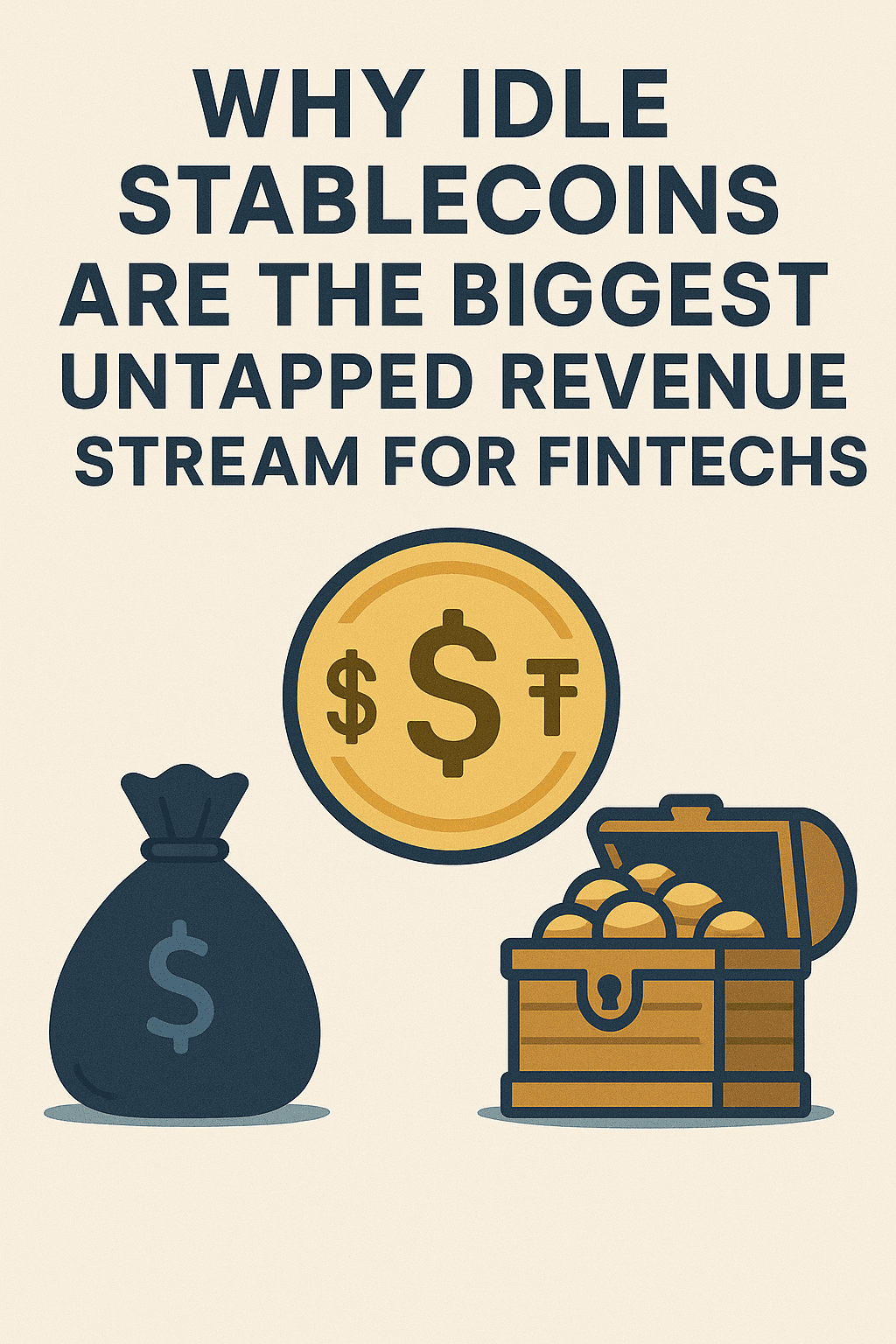The $600,000 Problem Every Fintech CEO is Ignoring
Picture this: Your fintech holds $10 million in stablecoin reserves for customer payouts, cross-border transfers, or operational float. While you're celebrating your latest funding round, those digital dollars are sitting completely idle, earning exactly zero return.
The harsh math? That's a $60,000-$90,000 annual difference per million dollars held. For businesses maintaining $10 million in stablecoin reserves, we're discussing $600,000-$900,000 in foregone annual revenue.
Meanwhile, your competitor across town just implemented a stablecoin yield strategy and is now subsidizing customer fees by 35% using yield revenue while you're fighting for margin on every transaction.This isn't theoretical. It's happening right now across the $230 billion stablecoin economy.
The Stablecoin Treasury Revolution is Here
The stablecoin market has exploded to over $230B in total market cap as of mid-2025, with new laws from the U.S., EU, and Asia on the way that will expand adoption even more. But here's what most fintechs miss: this isn't just about payments anymore.
Nearly 49% of financial institutions already use stablecoins, and another 41% are in pilot programs. Corporate treasuries are entering the on-chain era because yield-bearing stablecoins unlock 24/7 settlement, programmable cash flows, and major cost reductions.
The companies that figured this out early are already pulling ahead:
Latin American payment processor: Implemented stablecoin yield on $10M daily float, generating $800,000 in annual revenue from previously idle funds
E-commerce platform: Earns yield on $25M in escrow balances, reducing customer fees by 35% using yield subsidies
Digital bank: Offers 6-9% APY savings accounts without traditional banking infrastructure
Why Traditional Treasury Management is Broken for Digital Assets
Here's where most fintechs get stuck: they apply traditional treasury thinking to digital assets.
Traditional corporate treasury assumes your cash sits in checking accounts earning 0.5% or money market funds at 4-5%. But stablecoins operate in a fundamentally different ecosystem where:
Yields are higher: Leading Solana protocols like Kamino, Drift, and MarginFi currently offer 6-35% APY on stablecoin deposits
Liquidity is instant: Unlike traditional fixed deposits, most DeFi protocols offer immediate withdrawals
Operations are 24/7: No banking hours, no settlement delays, no wire transfer fees
The disconnect? Most fintech treasury teams don't know these opportunities exist.
The Four Categories of Idle Stablecoin Capital
Every fintech sits on multiple pools of idle stablecoin capital. Let's break down where the real money is hiding:
1. Operational Float (The Biggest Opportunity)
This is money in transit - funds received but not yet disbursed. For most fintechs, this represents 40-60% of total stablecoin holdings.
Real Example: Cross-border payment companies often hold customer funds for 6-48 hours during FX operations. A company processing $50M monthly could have $2-4M in constant float earning zero return.
Yield Potential: Even conservative lending protocols on Solana like Kamino currently offer 8-12% variable APY on USDC deposits, turning dead capital into meaningful revenue.
2. Escrow and Security Deposits
Marketplaces, real estate platforms, and B2B payment companies hold billions in escrow that could be earning yield while waiting for transaction completion.
The Innovation: Smart escrow protocols that earn yield during the holding period, then distribute returns between parties or use them to subsidize platform fees.
3. Customer Deposit Balances
Digital banks and neobanks holding customer stablecoin balances can offer competitive yield while maintaining full liquidity.
Competitive Advantage: Traditional banks offering 0.5% on deposits can't compete with fintech offering 6-8% APY on stablecoin balances.
4. Treasury Reserves
Working capital, emergency funds, and operational reserves that sit idle between use cases.
Strategy: Instead of holding cash in traditional bank accounts, progressive fintechs are moving treasury operations on-chain for better yields and 24/7 access.
The Yield Landscape: Where to Park Digital Assets in 2025
Not all yield is created equal. Here's the current landscape for stablecoin yields and how to think about risk-return profiles:
Conservative Strategies (4-8% APY)
Regulated Yield Sources: Tokenized treasury funds like BlackRock's BUIDL and Ondo's USDY provide 4-5% yields backed by U.S. Treasury bills. These offer institutional-grade safety with traditional finance backing.
Bank-Like Lending: Established protocols like Kamino (Solana's leading DeFi protocol with $2.44 billion TVL) offer 5-8% yields through lending markets, with yields varying based on demand.
Moderate Risk Strategies (8-15% APY)
DeFi Lending Protocols: Solana's ecosystem offers substantial yield opportunities with protocols like Solend, Kamino, and Drift providing 8-15% returns on stablecoin deposits.
Liquidity Provision: Providing liquidity to stablecoin trading pairs on decentralized exchanges, earning fees from trading volume.
Higher Risk Strategies (15%+ APY)
Insurance Fund Staking: Drift Protocol currently offers 40% variable APY on USDC staked in their Insurance Fund, though this comes with additional risks and a 13-day unstaking period.
Leveraged Strategies: Advanced yield farming techniques that can amplify returns but require sophisticated risk management.
The Regulatory Tailwind That Changes Everything
The regulatory landscape has fundamentally shifted in favor of stablecoin adoption:
The GENIUS Act Creates Partnership Opportunities
The July 2025 passage of the GENIUS Act fundamentally alters the stablecoin landscape, providing regulatory clarity while introducing new balance sheet advantages for banks engaging in stablecoin custody.
Here's the key insight: Stablecoin issuers cannot directly offer yield or interest on holdings under the GENIUS Act. This creates a massive partnership opportunity for yield infrastructure providers.
Banks and stablecoin issuers need partners to offer competitive yield products without violating regulations.
Global Regulatory Momentum
Several other banks and financial technology companies such as PayPal, Bank of America and Stripe have also launched stablecoins or indicated they intend to enter the market.
The regulatory clarity is accelerating institutional adoption, creating more demand for sophisticated yield infrastructure.
Implementation Strategies: From Zero to Yield in 30 Days
Getting started with stablecoin yield doesn't require rebuilding your entire treasury operation. Here's how progressive fintechs are implementing yield strategies:
Phase 1: Pilot with Operational Float (Week 1-2)
Start by implementing yield on your lowest-risk capital - operational float that you know will be held for predictable periods.
Minimum Viable Strategy:
Identify 20-30% of operational balances with predictable hold periods
Implement automated yield strategies on Solana protocols like Kamino or Drift
Monitor yields and establish operational procedures
Phase 2: Expand to Customer Deposits (Week 3-4)
Once operational procedures are established, expand to customer-facing yield products.
Customer Value Proposition:
Offer 5-8% APY on stablecoin deposits vs 0.5% traditional banks offer
Maintain instant liquidity and familiar user experience
Generate revenue share from yield spread
Phase 3: Optimize Entire Treasury (Month 2-3)
Implement comprehensive treasury optimization across all stablecoin holdings.
Advanced Strategies:
Automated rebalancing between yield sources based on market conditions
Dynamic yield allocation based on liquidity requirements
Integration with existing treasury management systems
The Competitive Moat: Why First Movers Win
The stablecoin yield opportunity isn't just about immediate revenue - it's about building sustainable competitive advantages:
Cost Structure Transformation
Companies can eliminate multiple bank accounts and FX conversion fees on operational costs.
Market Size: Over $8B in addressable opportunity as institutions seek blockchain-native treasury solutions.
Fintechs generating yield on float can:
Subsidize customer fees using yield revenue
Offer negative take rates on certain transactions
Reinvest yield into customer acquisition
Customer Acquisition and Retention
Offering 6-8% yield on stablecoin deposits when traditional banks offer 0.5% creates a massive customer acquisition advantage.
Product Differentiation
Fintech winners in 2025 won't have the best banking relationships, they'll have stablecoin infrastructure.
Companies that master yield generation can offer products impossible for traditional competitors:
Interest-bearing payment cards
Yield-generating escrow services
Dynamic pricing based on yield revenue
Real-World Case Study: Global Payment Processor Transformation
Here's how one Latin American payment processor transformed their business using stablecoin yield:
The Challenge: Processing $10M daily in cross-border payments with 8-hour average hold times, generating zero return on float.
The Solution: Implemented automated yield strategies on operational float:
70% in Solana lending protocols (Kamino/Drift)
30% in stablecoin liquidity pools
Automated rebalancing based on daily flow predictions
The Results:
$800,000 annual revenue from previously idle funds
Reduced customer fees by 35% using yield subsidies
Improved customer acquisition by 150% due to price competitiveness
The Competitive Impact: Competitors couldn't match pricing, leading to 40% market share increase in key corridors.
Technology Infrastructure: Building for Scale
Implementing stablecoin yield at scale requires the right infrastructure approach. Most fintechs make one of two mistakes:
The DIY Trap: Trying to build yield optimization in-house, which requires deep DeFi expertise and ongoing maintenance
The Centralized Trap: Using centralized yield providers that introduce custodial risk and regulatory complexity
The optimal approach combines institutional-grade infrastructure with blockchain-native capabilities.
Key Infrastructure Requirements
Custody-Agnostic Operations: Maintain control of funds while accessing yield opportunities across multiple protocols.
Automated Optimization: Dynamic allocation between yield sources based on market conditions and liquidity requirements.
Risk Management: Real-time monitoring, diversification controls, and emergency procedures.
Regulatory Compliance: Built-in compliance capabilities for reporting and audit requirements.
The $2 Trillion Opportunity: Market Size and Growth Projections
The opportunity is massive and growing rapidly:Standard Chartered estimates stablecoin supply could rise from $230 billion today to $2 trillion by year-end 2028.
But the real opportunity isn't just market size - it's the inefficiency in current capital allocation:
Current Idle Capital: Stablecoins represent over $130 billion in global circulating supply, yet the majority remain idle—sitting in wallets, exchanges, and payment platforms without generating value
Addressable Market: Over $8B in addressable opportunity as institutions seek blockchain-native treasury solutions
Growth Drivers: The retirement market worth $43 trillion, with $9 trillion in 401(k) plans, could create massive new demand for compliant, institutional-grade stablecoin infrastructure
Risk Management: Avoiding the Yield Trap
High yields come with risks. Here's how sophisticated fintechs manage downside while capturing upside:
Smart Contract Risk Mitigation
Multi-Protocol Diversification: Spread exposure across audited protocols
Gradual Deployment: Start with small allocations and scale based on performance
Insurance Coverage: Use protocols with insurance funds or purchase additional coverage
Regulatory Risk Management
The SEC's April 2025 statement clarified yield-bearing stablecoin regulations, while the GENIUS Act provides framework for institutional adoption.
Key considerations:
Maintain compliance documentation
Work with crypto-aware legal counsel
Implement proper tax reporting procedures
Operational Risk Controls
Liquidity Buffers: Maintain adequate liquid reserves for operational needs
Automated Monitoring: Real-time alerts for protocol health and yield changes
Emergency Procedures: Predefined exit strategies for various scenarios
The Competition is Already Moving
While many fintechs are still debating whether to implement stablecoin yield, the leaders are already capturing market share:
OpenTrade, an institutional-grade infrastructure platform specialising in real-world asset-backed stablecoin yield products, has closed a $7m funding round. The company operates a B2B2C "yield-as-a-service" platform that allows FinTechs, exchanges, and neobanks to integrate stablecoin yield offerings directly into their services.
The message is clear: yield-as-a-service is becoming table stakes for competitive fintech offerings.
Implementation Timeline: 90-Day Roadmap
Here's how to implement stablecoin yield in your organization:
Days 1-30: Foundation and Pilot
Week 1: Assess current stablecoin holdings and identify yield opportunities
Week 2: Select yield infrastructure provider and establish pilot parameters
Week 3: Implement pilot on 10-20% of operational float
Week 4: Monitor performance and refine procedures
Days 31-60: Expansion and Optimization
Week 5-6: Scale pilot to 50% of appropriate balances
Week 7-8: Implement customer-facing yield products
Days 61-90: Full Implementation
Week 9-10: Optimize entire treasury operation
Week 11-12: Measure impact and plan next phase expansion
The Bottom Line: Act Now or Fall Behind
The stablecoin yield opportunity represents one of the rare instances where doing the right thing for your business also benefits your customers.
You can:
Generate substantial revenue from idle capital
Offer better rates to customers than traditional competitors
Build competitive moats through cost structure advantages
Future-proof your business for the digital asset economy
The question isn't whether to implement stablecoin yield - it's how quickly you can move relative to your competition.
Market value jumped from $1.5B to $11B in just 18 months. JPMorgan predicts yield-bearing stablecoins could reach 50% market share. Regulatory clarity through the GENIUS Act has validated the business model. Combined, these trends represent $84B+ in market opportunities by 2026.
Getting Started: Your Next Steps
The path forward is clear:
Audit your current stablecoin holdings - identify idle capital across operational float, escrow, and reserves
Calculate your opportunity cost - quantify the revenue you're leaving on the table
Implement a pilot program - start with a small percentage of low-risk balances
Scale based on results - expand as you build operational confidence
The companies that move now will build insurmountable competitive advantages. The companies that wait will find themselves competing on margin while their competitors generate revenue from the same transactions.
The $230 billion stablecoin economy is just getting started. The question is whether your fintech will capture its share of the yield opportunity or watch competitors use that revenue to outcompete you on price.
The race for stablecoin yield supremacy has already begun. The only question is whether you're running or watching from the sidelines.
Ready to transform your idle stablecoins into revenue-generating assets? Modern infrastructure providers are making it easier than ever to implement yield strategies without the complexity of managing DeFi protocols directly. The technology exists. The opportunity is proven. The only question is execution speed.



